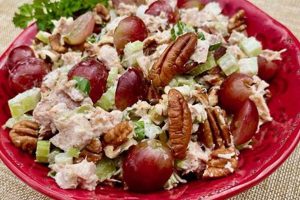A simple preparation involving cooked chicken, typically from a store-bought rotisserie bird, combined with mayonnaise and other ingredients such as celery, onion, and seasonings. This dish offers a convenient and flavorful meal option, often served on bread, crackers, or lettuce wraps. Variations can include grapes, nuts, dried cranberries, or different herbs and spices.
This type of dish offers convenience, affordability, and nutritional value. Utilizing pre-cooked chicken significantly reduces preparation time, making it ideal for quick meals. Rotisserie chickens are generally cost-effective, and the salad itself can be adapted to incorporate a variety of fresh produce, boosting its nutritional content. Such preparations have become a modern staple, evolving from traditional chicken salad recipes that required cooking the chicken from scratch. This evolution reflects the increasing demand for convenient yet wholesome meal options.
The following sections will explore various aspects of creating this culinary delight, including ingredient selection, preparation techniques, and serving suggestions. Considerations for dietary restrictions and creative variations will also be addressed.
Tips for a Delicious Rotisserie Chicken Salad
Optimizing flavor and texture requires attention to several key aspects of preparation. The following tips provide guidance for creating a superior culinary experience.
Tip 1: Chicken Selection and Preparation: Opt for high-quality rotisserie chicken. Remove skin and bones thoroughly, and shred or dice the meat into desired bite-sized pieces. Consistent piece size ensures even distribution of flavor and a pleasing texture.
Tip 2: Mayonnaise Matters: The choice of mayonnaise significantly influences the overall taste. Experiment with different types, such as full-fat, low-fat, or olive oil-based, to find a preferred flavor profile. The quantity of mayonnaise can be adjusted to achieve desired creaminess.
Tip 3: Elevating with Fresh Ingredients: Incorporating freshly chopped celery and onion provides a crisp, refreshing contrast to the richness of the chicken and mayonnaise. Finely dicing these ingredients ensures even distribution and prevents overpowering flavors.
Tip 4: Seasoning Strategically: Salt and pepper are essential, but consider enhancing the flavor profile with additional seasonings. Garlic powder, onion powder, paprika, or a pinch of cayenne pepper can add depth and complexity.
Tip 5: Textural Variety: Nuts, such as chopped pecans or walnuts, and dried fruits, like cranberries or raisins, add pleasing textural contrasts and complementary flavors.
Tip 6: The Power of Fresh Herbs: Fresh herbs, such as chopped chives, parsley, or dill, contribute bright, vibrant flavors. Add these towards the end of preparation to maintain their freshness and aroma.
Tip 7: Chill Out: Allowing the salad to chill in the refrigerator for at least 30 minutes allows the flavors to meld and enhances the overall experience. Chilling also firms the salad, making it easier to handle and serve.
By adhering to these guidelines, one can create a dish that is both satisfying and flavorful. Attention to detail in ingredient selection, preparation, and chilling contributes significantly to the final product.
The following section will offer serving suggestions and explore potential variations to further customize this versatile dish.
1. Rotisserie Chicken
Rotisserie chicken forms the foundational ingredient of easy rotisserie chicken salad recipes. Its presence transforms the preparation process, significantly reducing cooking time and simplifying the overall effort. Without pre-cooked rotisserie chicken, the recipe necessitates cooking raw chicken, adding complexity and time. This convenience factor contributes substantially to the “easy” aspect of the recipe, making it a practical choice for quick meals. Consider the scenario of a weeknight dinner: utilizing a readily available rotisserie chicken allows for a rapid salad assembly, as opposed to dedicating time to poultry preparation from scratch. This reliance on a pre-cooked element establishes a direct cause-and-effect relationship between rotisserie chicken availability and the ease of the recipe.
Furthermore, rotisserie chicken imbues the salad with distinct flavor characteristics. The slow-roasting process imparts a unique smoky flavor and tender texture, which are difficult to replicate with other cooking methods. This inherent flavor profile contributes significantly to the overall palatability of the salad. For example, a salad made with rotisserie chicken versus boiled chicken offers a richer, more nuanced taste experience. Understanding the impact of the rotisserie process on flavor development allows for informed ingredient selection and flavor pairing decisions within the recipe.
In conclusion, the relationship between rotisserie chicken and easy rotisserie chicken salad recipes is fundamental. Rotisserie chicken serves not merely as a component, but as a defining element, influencing both the simplicity of preparation and the final flavor profile. This understanding highlights the practical significance of ingredient selection and its impact on the overall culinary outcome. Recognizing this connection allows for informed choices when adapting or creating variations of this versatile dish.
2. Mayonnaise
Mayonnaise plays a crucial role in easy rotisserie chicken salad recipes, functioning as a binding agent, flavor enhancer, and textural component. Its presence unites disparate ingredients shredded chicken, diced vegetables, seasonings into a cohesive mixture. Without mayonnaise, the ingredients remain separate, lacking the creamy consistency characteristic of chicken salad. Consider a scenario where olive oil is substituted for mayonnaise: the resulting mixture lacks the necessary emulsification to bind the ingredients together, resulting in a loose, potentially oily, and less desirable texture. This illustrates the cause-and-effect relationship between mayonnaise and the desired consistency of the salad.
Beyond its binding properties, mayonnaise contributes significantly to the flavor profile. The rich, tangy flavor complements the savory chicken and adds depth to the overall taste experience. Different types of mayonnaise, such as those made with olive oil or flavored with herbs, can further enhance or modify the flavor profile. For example, using a lemon-herb mayonnaise introduces a bright, citrusy note, while a chipotle mayonnaise adds a smoky, spicy dimension. Understanding these nuances allows for strategic flavor customization within the recipe.
The quantity of mayonnaise also influences the final texture. A higher mayonnaise-to-chicken ratio produces a creamier, richer salad, while a lower ratio yields a chunkier, less creamy result. This variability allows for customization based on individual preferences. Overuse of mayonnaise, however, can lead to an excessively rich and heavy salad, potentially masking the flavors of other ingredients. Conversely, insufficient mayonnaise can result in a dry, crumbly texture. Finding the optimal balance is key to achieving the desired textural and flavor balance.
In conclusion, mayonnaise serves as a fundamental component of easy rotisserie chicken salad recipes. Its contributions extend beyond simply binding ingredients together; it significantly impacts the overall flavor, texture, and palatability of the final dish. Recognizing the multifaceted role of mayonnaise empowers informed decision-making regarding ingredient selection and proportion, ultimately leading to a more satisfying culinary outcome.
3. Celery
Celery contributes a distinct textural and flavor dimension to easy rotisserie chicken salad recipes. Its crisp, fibrous stalks offer a refreshing counterpoint to the richness of the chicken and mayonnaise. This textural contrast prevents the salad from becoming overly homogenous and adds a satisfying crunch. Without celery, the salad’s texture might be perceived as monotonous, lacking the dynamic interplay between soft and crisp elements. Consider a scenario where finely diced water chestnuts are substituted for celery: while offering a similar crunch, the subtle sweetness of water chestnuts alters the overall flavor profile, demonstrating celery’s unique textural and flavor contribution.
Beyond texture, celery’s subtly vegetal flavor enhances the overall complexity of the salad. Its mild bitterness balances the richness of the mayonnaise and complements the savory chicken. This delicate flavor integration prevents the salad from becoming overly rich or one-dimensional. For instance, substituting celery with shredded carrots introduces a pronounced sweetness, shifting the flavor balance and potentially clashing with other ingredients. This underscores the importance of celery’s specific flavor profile in achieving a harmonious balance within the recipe.
Celery’s practical significance extends to its ease of incorporation. Its readily available nature and simple preparationtypically involving washing and dicingalign with the “easy” aspect of the recipe. The inclusion of celery requires minimal additional effort, contributing to the overall convenience of the dish. This ease of use further solidifies celery’s role as a valuable component of a quick and flavorful meal option.
In conclusion, celery’s contribution to easy rotisserie chicken salad recipes is multifaceted. Its textural and flavor properties, combined with its ease of use, establish its importance within the recipe framework. Understanding celery’s distinct characteristics allows for informed adjustments and substitutions, ensuring a consistently satisfying and well-balanced culinary outcome.
4. Onion
Onion, in its various forms, contributes a pungent, savory depth to easy rotisserie chicken salad recipes. Its sharp flavor profile, whether derived from red, yellow, or white varieties, provides a crucial counterpoint to the richness of the chicken and mayonnaise. This complexity prevents the salad from becoming bland, adding a layer of flavor that elevates the overall experience. Omitting onion entirely can result in a one-dimensional taste, lacking the sharp bite that balances the other ingredients. Consider substituting onion with bell peppers: while adding a contrasting crunch, the sweetness of bell peppers fails to replicate onion’s distinct pungency, highlighting its unique contribution to the flavor profile. This illustrates a direct cause-and-effect relationship between onion’s presence and the recipe’s overall flavor balance.
Beyond raw onion, alternatives such as caramelized or pickled onions offer nuanced variations on this theme. Caramelized onions introduce a subtle sweetness and depth, complementing the savory chicken, while pickled onions offer a tangy, acidic counterpoint that brightens the overall flavor profile. The choice of onion preparation method, therefore, allows for customized flavor modulation within the recipe. For example, incorporating pickled red onions introduces both a vibrant color and a tangy burst, further enhancing the salad’s complexity. Understanding these variations empowers informed ingredient selection to achieve specific flavor outcomes.
The quantity of onion used also impacts the final result. Too much raw onion can overpower the other flavors, while too little might render its contribution negligible. Finding the optimal balance is crucial for a harmonious flavor profile. This underscores the practical significance of precise ingredient measurement and the impact of proportional adjustments on the final dish. Furthermore, the choice between finely diced onion versus coarsely chopped pieces influences both texture and flavor release, offering additional avenues for customization. Recognizing these nuances allows for greater control over the sensory experience of the final product.
In conclusion, onion serves as a vital flavor component in easy rotisserie chicken salad recipes. Its sharp flavor, varied preparation methods, and controllable intensity contribute significantly to the overall culinary experience. Understanding onion’s multifaceted role allows for informed ingredient selection and strategic flavor manipulation, ensuring a well-balanced and satisfying final dish.
5. Seasoning
Seasoning plays a critical role in elevating easy rotisserie chicken salad recipes from simple to exceptional. The judicious use of salt, pepper, and other spices enhances the inherent flavors of the chicken, vegetables, and mayonnaise, creating a more complex and satisfying flavor profile. Without proper seasoning, the salad can taste bland and underwhelming, failing to capitalize on the potential of its individual components. Consider a scenario where only salt is used: while providing basic salinity, the salad lacks depth and complexity. Substituting salt with soy sauce, while adding saltiness, introduces an entirely different flavor profile, demonstrating the specific impact of seasoning choices.
Beyond basic salt and pepper, a wide array of spices and herbs can further enhance the flavor profile. Garlic powder, onion powder, paprika, and cayenne pepper can add depth and warmth, while dried herbs such as dill, thyme, or oregano can introduce subtle herbal notes. Fresh herbs, such as chives, parsley, or tarragon, offer brighter, more vibrant flavors. The selection of specific seasonings allows for customization and creativity, tailoring the flavor profile to individual preferences. For instance, a combination of curry powder and mango chutney can transform the salad into an flavorful, Indian-inspired dish. Understanding the interplay of different spices and herbs allows for strategic flavor development within the recipe.
The quantity of seasoning used also requires careful consideration. Over-seasoning can overwhelm the delicate flavors of the other ingredients, while under-seasoning can result in a bland and uninspired dish. Finding the optimal balance is crucial for achieving a harmonious and well-rounded flavor profile. This highlights the practical significance of precise measurement and the impact of incremental adjustments on the final result. Furthermore, the timing of seasoning additions can influence the final outcome. Adding certain spices early in the mixing process allows them to meld and integrate more fully, while adding fresh herbs towards the end preserves their vibrant flavors and aromas.
In conclusion, seasoning acts as a crucial element in transforming easy rotisserie chicken salad recipes from basic to exceptional. The strategic selection and application of spices and herbs, combined with careful attention to quantity and timing, significantly impact the overall flavor profile and elevate the culinary experience. Understanding these nuances empowers informed decision-making, enabling the creation of a truly satisfying and flavorful dish.
6. Quick Preparation
The “quick preparation” aspect is integral to the concept of an easy rotisserie chicken salad recipe. Pre-cooked rotisserie chicken eliminates the most time-consuming element of traditional chicken salad preparation: cooking the chicken. This significantly reduces the overall time investment, making the recipe accessible for even the busiest individuals. Consider the contrast: preparing chicken salad from raw poultry requires cooking, cooling, and shredding the meat, adding a significant time burden. Utilizing rotisserie chicken streamlines the process, allowing for a complete meal preparation in a fraction of the time. This direct cause-and-effect relationship between the use of pre-cooked chicken and reduced preparation time establishes the “easy” and “quick” nature of the recipe.
Furthermore, the remaining componentsmayonnaise, celery, onion, and seasoningstypically require minimal processing. Chopping vegetables and combining ingredients takes only a few minutes, further contributing to the recipe’s speed and convenience. This ease of assembly makes it an ideal choice for weeknight meals, quick lunches, or even last-minute gatherings. Imagine a scenario where a more complex protein, such as grilled steak, is substituted: the preparation time increases significantly due to the marinating, grilling, and resting required. This comparison underscores the practical significance of ingredient selection and its impact on overall preparation time within the context of an “easy” recipe.
In conclusion, the “quick preparation” aspect of easy rotisserie chicken salad recipes hinges on the utilization of pre-cooked chicken and readily available ingredients. This efficiency translates to a significant reduction in time investment, making the recipe a practical and convenient choice for a variety of meal occasions. Recognizing this connection between ingredient selection and preparation time empowers informed choices regarding recipe adaptations and substitutions while maintaining the core value of speed and simplicity. This understanding is crucial for anyone seeking efficient and flavorful meal solutions.
7. Versatile Serving
The “versatile serving” aspect significantly contributes to the overall appeal of easy rotisserie chicken salad recipes. This adaptability stems from the salad’s inherent malleability and its compatibility with a wide range of serving methods. This versatility translates to practical meal solutions for diverse occasions, from casual lunches to more formal gatherings. Consider the contrast: a complex casserole, while potentially delicious, limits serving options due to its inherent structure and presentation. Chicken salad, however, adapts effortlessly to various formats, expanding its utility and appeal. This inherent flexibility establishes a direct cause-and-effect relationship between the recipe’s adaptability and its suitability for diverse dining contexts.
The salad’s versatility manifests in numerous ways. It can be served as a sandwich filling, nestled between slices of bread, croissants, or wraps. It can be scooped onto crisp lettuce cups for a lighter, low-carbohydrate option. It can be served as a dip with crackers, vegetables, or chips. It can also function as a main course salad, accompanied by a variety of greens and other complementary ingredients. For example, serving the salad on toasted baguette slices with a side of mixed greens elevates the presentation for a more formal setting, while incorporating it into a wrap with fresh vegetables creates a portable and convenient lunch option. This adaptability not only expands the recipe’s practical applications but also allows for creative presentation and customization based on individual preferences and dietary needs. This understanding of serving versatility empowers informed choices, expanding meal planning possibilities.
In conclusion, “versatile serving” functions as a key attribute of easy rotisserie chicken salad recipes. This adaptability stems from the salad’s inherent flexibility and compatibility with diverse serving methods. This characteristic enhances the recipe’s practical value, allowing for seamless integration into a wide range of meal scenarios, from casual to formal. This understanding of serving versatility empowers informed choices regarding presentation and customization, making the recipe a valuable asset for efficient and adaptable meal planning. Recognizing this connection between versatility and practicality underscores the recipe’s overall appeal and its place as a staple in many kitchens.
Frequently Asked Questions
This section addresses common inquiries regarding the preparation and utilization of easy rotisserie chicken salad recipes.
Question 1: How long can rotisserie chicken salad be stored in the refrigerator?
Properly stored in an airtight container, rotisserie chicken salad typically remains safe to consume for three to five days in the refrigerator. Beyond this timeframe, the risk of bacterial growth increases significantly.
Question 2: Can frozen rotisserie chicken be used for this recipe?
While frozen rotisserie chicken can be used, it is essential to thaw it completely and thoroughly pat it dry before incorporating it into the salad. Excess moisture can negatively impact the texture and flavor of the final product.
Question 3: What are suitable substitutions for mayonnaise in this recipe?
Plain Greek yogurt or avocado can serve as healthier alternatives to mayonnaise, offering a lighter texture and different flavor profiles. These substitutions can also cater to dietary restrictions or preferences.
Question 4: How can the flavor profile of the salad be adjusted to accommodate different preferences?
Adjusting the types and quantities of seasonings, herbs, and other ingredients can significantly modify the flavor profile. Incorporating ingredients such as curry powder, grapes, nuts, or different types of onions allows for customized flavor variations.
Question 5: What are suitable bread or cracker options for serving rotisserie chicken salad?
A variety of breads and crackers complement rotisserie chicken salad. Options include croissants, whole-wheat bread, sourdough bread, crackers, pita bread, or even lettuce wraps for a low-carbohydrate alternative. The choice depends on individual preferences and dietary needs.
Question 6: Can rotisserie chicken salad be frozen?
Freezing rotisserie chicken salad is generally not recommended. The mayonnaise-based dressing can separate and become watery upon thawing, negatively impacting the texture and overall quality of the salad.
Understanding these common inquiries provides a foundation for successful rotisserie chicken salad preparation and enjoyment. Addressing potential challenges proactively ensures a satisfying culinary experience.
The following section will offer a selection of recipe variations to inspire culinary exploration and customization.
Easy Rotisserie Chicken Salad Recipe
Exploration of easy rotisserie chicken salad recipes reveals a dish characterized by simplicity, versatility, and flavor. Utilizing pre-cooked rotisserie chicken significantly streamlines preparation, while the incorporation of mayonnaise, celery, onion, and seasonings establishes a foundational flavor profile. Customization through varied ingredients, seasonings, and serving methods allows for diverse culinary expressions. Understanding the function and impact of each component empowers informed choices, ensuring optimal flavor and texture.
Easy rotisserie chicken salad recipes represent a practical and adaptable meal solution for diverse occasions. Continued exploration of flavor combinations and creative presentations promises further culinary evolution, solidifying its place as a timeless and adaptable dish.






